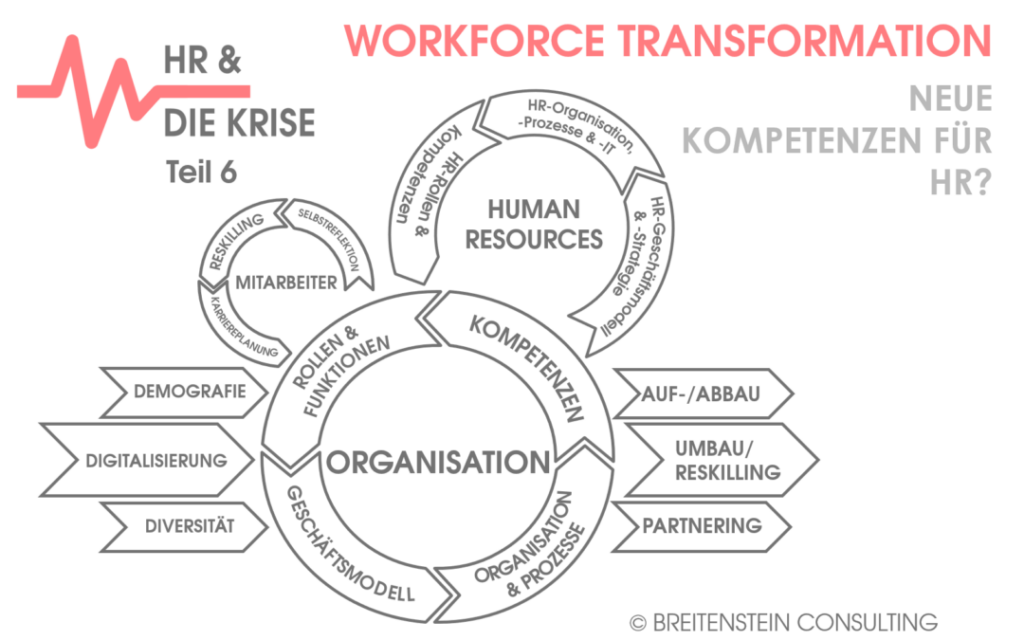Workforce transformation is a strategic challenge for Human Resources. The age-old question keeps coming up: Is this our role as HR? And do we even have the right skills? I would like to take a closer look at these questions in this article. As always, with practical experience.
What does Strategic Workforce Transformation require from Human Resources?
Actually, it’s nothing really new:
Workforce transformation requires a look into the future, making assumptions about future skills, roles, processes or even business models and bringing these into the present in order to be able to plan.
You look at technologies and trends, make scenarios and deductions and develop measures.
A training manager has always paid attention to the future skills of his trainees. Or the rollout of CNC machines in the 90s was also a quantum leap in the digitalization of production. The construction of a new production site in China had to be planned and implemented.
HR somehow managed it all!
This time it’s different …
The dynamics and complexity are higher: digital technologies (artificial intelligence, blockchain, 3D/AR, mobile applications, etc.) have a deeper impact and are changing business models in many sectors at the same time. They now tend to tackle more highly skilled tasks. Global competition for platforms and standards is raging. At the same time, mobile applications make it possible to break away from locations and protected labor markets. Other social trends such as demographics, changing values towards diversity and the ongoing restructuring of the economic system towards decarbonization are reinforcing, enabling and accelerating all of these developments and are mutually dependent. For us Europeans, there is also the marginalization of many industries by better/faster Asian manufacturers and the increasing distance to the American tech giants.
These changes are no longer taking place in slow, recognizable waves that we can react to when they occur, but in some cases so quickly that many of our entrenched company structures are no longer able to react. Our labor and training markets are complex systems and therefore slow. In the end, the only option would be to downsize or withdraw from the business or outsource the respective activity or employee.
So you have to find a way to anticipate these trends and their effects on skills requirements, roles, processes or entire businesses in order to be able to initiate measures early enough. A little ‚HR intuition‘ or having a ‚nose‚ is no longer enough. Workforce transformation must become a core instrument of HR, which in some cases requires new methodological and strategic skills. But these can be learned.
What new skills does HR need?
At the end of the day, strategic workforce transformation is nothing more than strategy work. Millions of consultants and business strategists do this. The other is implementing the findings in a people and HR strategy. And then, of course, change management so that it doesn’t remain an aerial exercise.
- Awareness: As easy as it is to postulate here that no stone will be left unturned in many companies in the next 10 years, it is really difficult to assume. How do you create a sense of urgency? How does the business react when the HR manager of all people comes and talks about digitalization? And then also wants resources for such a project. This positioning work in the management team requires good preparation and a storyline.
- Project approach: Good projects integrate qualitative and quantitative instruments. Is it about an entire production process, a business model or just a functional group? WFT is always a project and requires a project management method that usually always includes agile and classic elements.
- Resources: Workforce transformation is not a workshop that can be done ‚on the side‘. If you really want to do it systematically, you need resources in HR, from management and the specialist departments. Consultants may also be needed. And quantitative resources usually also require a tool and a lot of processed HR data. Here we are talking about classic project resource planning (even with agile approaches!). And then, of course, a proper kick-off.
- Trend analysis: What are the relevant trends that will have an impact on our business? As I said, many trends often overlap. Here you have to do research and, above all, think and work in scenarios. This is a highly creative process that will have a lot to do with agile tools or design thinking. And it is also always a reduction to decisive drivers and impact factors – also in order to be able to usefully feed an IT tool later on, for example. Strategists learn to turn speculation into quantitative facts. Or at least to argue on the basis of evidence. You can learn a lot from that.
- Impact analysis: It’s always about predicting how changes in technologies, markets, etc. will affect your own roles, processes or business. In the end, HR people always think in terms of roles and competencies. And that’s where you have to end up. This is one level deeper than business strategists usually think. In my opinion, this translation work is the original contribution of HR. In the end, everything has to come down to roles, competencies and the necessary figures behind them. With or without a tool.
- People strategy: It has never made more sense to differentiate between a people strategy and an HR strategy. A people strategy involves more than ‚just‘ trend analyses and their impact on jobs. Instead, a business may have independent growth plans, strategy changes, regional development plans and new products. Getting all of this together into a meaningful people strategy that is aligned with the business strategy for a period of 3-7 years – plus the commitment of top management. That is the challenge.
- HR strategy: At Breitenstein, we always differentiate between the people strategy and the HR strategy. A people strategy encompasses all aspects relating to the deployment of people in an organization. An HR strategy is a functional strategy that supports the people strategy at its core. But HR is not the only function that has to implement a people strategy – everyone does. HR provides the tools to do this. Workforce transformation needs this distinction to make it clear that it is not a functional task of the HR organization, but must always be an essential part of the business strategy. And it is precisely this that allows HR to reposition itself strategically and also demand the necessary resources than in the past
- Controlling: It has never been as important as it is today. Once you have arrived at quantitative planning (however rudimentary it may be, with many uncertain parameters), you are in a position to define KPIs as controlling parameters. And far above the level of headcount and personnel costs. Giving up this strategic advantage would be criminal. Especially as such trend-induced forecasts are naturally volatile and you can only avoid falsification if you have several parameters to keep an overview. Then you can also sharpen the WTP in good time.
- Change management: As outlined in the last article, one of the most important effects of such scenarios is the pull effect. This means that people understand them, predict their own future and run towards it. Change management is therefore a very important lever for presenting the (plausible and quantified) scenarios and measures. Why are we doing this reorganization now? Why is this seminar so important? Why do we need a new training course or a new trainee program? You have to be able to sell the plans and scenarios properly. Strategic storytelling and a communication strategy must be developed.
- Scaling and iteration: It is very likely that you will start small with a process like this – for example with a family of functions. You will see successes and learn for the next project. And with each subsequent one, you gain insights and measures that can be scaled up. Possibly leading to an increasingly consistent overall picture and a vision for the organization as a whole.
We have experience and tools for such projects and also offer competence development curricula for Human Resources employees to set up and manage such projects.




